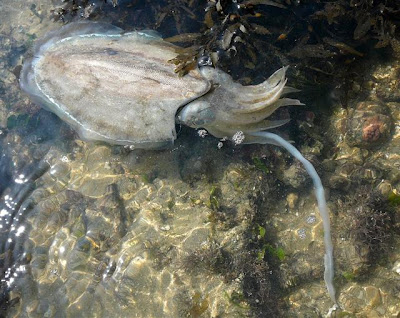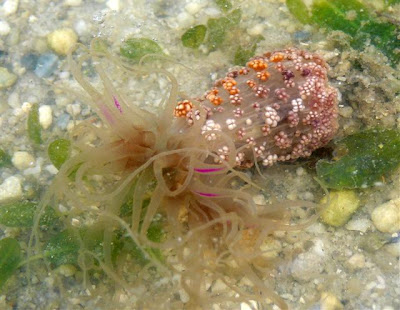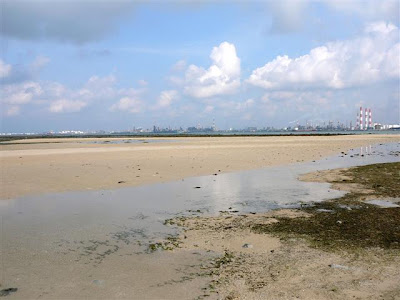Early in the morning, between predawn to dawn, the gang is out at the southern Singapore straits heading to Cyrene Reef again. We are back!
Upon a safe amphibous landing onto the sand bar, this intricate looking sole fish was spotted. It has red eyes if you notice and therefore it does give an evil feeling.
The nemo found at the same Gigantea anemone was still around. This time, two was spotted instead of one, though I could only take one photograph at a time as they are extremely shy creatures.
A stunning trip must be accompanied by a stunning red coloured feather star.
Also an echinoderm, this sea cucumber looks weird and we don't know what it is.
Another sea cucumber, this one found by Sam. Apparently, it is shitting! Look closely.
The whole place was so star studded that I didn't bother to take many knobbly photos. Sijie and Chee Kong recorded about 40 plus knobbly sea stars and there's also even more that wasn't recorded. Wow.
This one is interesting. Ivan spotted the snapping shrimp (thanks Ivan for the correction) on top of the knobbly, like hoping the knobbly be away. We suspected its home is beneath the star, and true enough after we removed the star, the shrimp went into a hole underneath. :-)
Sam found this Nepanthia belcheri at the seagrass area. This is also the same species as the one I found the last time. But this one has six arms!
Sam found many interesting animals today. Somehow he has lost his battery life for his camera, and after which he found many interesting stuffs. Haha.
If you look closer, this sea star has furry looking tube-like structure from the aboral surface.
An underside of this red attractive sea star.
I spotted two large sea urchins that the guys around almost could step on it since they didn't see them.
The underside reveal a star shaped structure, indicating evidence that it is an echinoderm with pentaradial symmetry.
Next, we headed to the reef area at the South. Basically, Cyrene Reef is made up of three reefs and we are at Terumbu Pandan. The beacon and the reef there is the second one, it is called the South Cyrene Beacon.
If I'm not wrong, it's the first time I photographed this different looking fan worm that looks really elegant and gentle. Yet, if you are closer to it, it will contract back into its tube.
A black cuttlefish was spotted by collin.
And I spotted later a large white one that looks really slack, in fact I think it is dying though it still can release black ink.
Many 1-2cm sized phyllid nudibranchs are around on top of the numerous leaf slugs and the Glossodoris atromarginata.
This photo only shows part of this real long ribbon worm. Can you imagine its length?
A small eel tries to hide either from the heat or from me. Haha.
The carpet eel blenny is usually mistaken as a snake by some people.
Sam called out and it was a feathery file fish resting beside a leathery soft coral.
Apart from soft corals, there are also hard corals in Cyrene Reef!
This hard coral looks like a Montipora species.
I have not seen this anemone before and it is really cute! It has colourful bumps on the body column.
And here is the top view of the anemone.
Cyrene Reef is also a great place for birds to take a break and fill their stomach. I saw a bird diving for fish yesterday!
Like Chek Jawa, Cyrene Reef also has great crested terns (thanks Ivan again for the id) resting during the low tide.
A close up of these really cute birds!
Towards the end of the trip, a four armed knobbly was spotted. Poor guy somemore got one of its four arm bitten off by predator.
It's time to leave this oasis and looking forward to return sometime soon, during the next low tide season.
Friday, May 9, 2008
Another fantastic trip out at Cyrene Reef
Subscribe to:
Post Comments (Atom)



































5 comments:
Could the looks-like-gonna-die cuttlefish just pro-created, and thus at the end of it's lifespan? Since there's that long white arm/tentacle looks like it may have jut done some real important business!
We saw it at Changi last time: see http://www.flickr.com/photos/budak/1472360843/in/set-72157601048422870/
Dr. Daphne think its "a member of family Aliciidae, probably *Phyllodiscus*... the distinction among genera of that family is the source of the growths from the column -- at only the base, only the middle, or all over."
She adds that they "can sting humans fairly severely. And the tentacles are usually retracted during the day, coming out only at night".
Hey Marcus, thanks for sharing about the really cute anemone!
Eh, snapping shrimp lah, not mantis shrimp. =)
And I think the terns we saw on Cyrene are great crested terns; black-naped terns don't have the black cap.
Juanicths: Possible, but it seems that where it comes to mating, male cuttlefish use specially adapted arms, not the long tentacles.
Opps, sorry about the shrimp mistake. Shows how sleep deprived I am. Haha!
Post a Comment